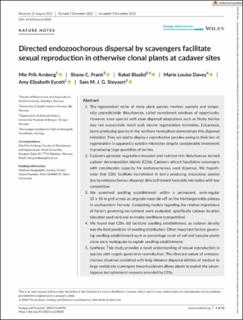Directed endozoochorous dispersal by scavengers facilitate sexual reproduction in otherwise clonal plants at cadaver sites
Arnberg, Mie Prik; Frank, Shane; Blaalid, Rakel; Davey, Marie Louise; Eycott, Amy Elizabeth; Steyaert, Sam
Peer reviewed, Journal article
Published version

View/
Date
2022Metadata
Show full item recordCollections
- Publikasjoner fra CRIStin - NINA [2364]
- Scientific publications [1392]
Abstract
1. The regeneration niche of many plant species involves spatially and tempo -rally unpredictable disturbances, called recruitment windows of opportunity. However, even species with clear dispersal adaptations such as fleshy berries may not successfully reach such elusive regeneration microsites. Ericaceous, berry- producing species in the northern hemisphere demonstrate this dispersal limitation. They are said to display a reproductive paradox owing to their lack of regeneration in apparently suitable microsites despite considerable investmentin producing large quantities of berries.2. Cadavers generate vegetation-denuded and nutrient-rich disturbances termedcadaver decomposition islands (CDIs). Cadavers attract facultative scavengerswith considerable capacity for endozoochorous seed dispersal. We hypoth -esize that CDIs facilitate recruitment in berry- producing ericaceous species due to endozoochorous dispersal directed toward favorable microsites with low competition.3. We examined seedling establishment within a permanent, semi- regular 10× 10 m grid across an ungulate mass die- off on the Hardangervidda plateau in southeastern Norway. Competing models regarding the relative importance of factors governing recruitment were evaluated, specifically cadaver location (elevated seed rain) and microsite conditions (competition).4. We found that CDIs did facilitate seedling establishment, as cadaver density was the best predictor of seedling distribution. Other important factors govern -ing seedling establishment such as percentage cover of soil and vascular plants alone were inadequate to explain seedling establishment.5. Synthesis: This study provides a novel understanding of sexual reproduction in species with cryptic generative reproduction. The directed nature of endozoo-chorous dispersal combined with long- distance dispersal abilities of medium to large vertebrate scavengers toward cadavers allows plants to exploit the advan -tageous but ephemeral resource provided by CDIs.
